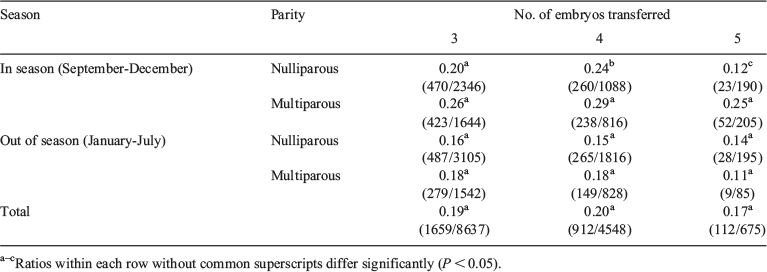94 Impact of number of embryos transferred on the number of offspring produced in a commercial transgenic founder production operation
N. Buzzell A , S. Blash A , K. Miner A , M. Schofield A , J. Pollock A , N. Hawkins A , M. Hevy A and W. Gavin ALFB USA Inc., Framingham, MA, USA
Reproduction, Fertility and Development 31(1) 173-173 https://doi.org/10.1071/RDv31n1Ab94
Published online: 3 December 2018
Abstract
The production of transgenic founder dairy goats (cross-bred Saanens, Alpines, Toggenburgs, and Nubians) involves the collection, microinjection, and transfer of numerous embryos into suitable recipient goats to ultimately produce a transgenic founder(s). The objective of this study was to determine the most efficient number of microinjection embryos to transfer to suitable recipients for transgenic founder generation. This is critically important in a commercial production program, as it impacts the goal for the number of embryos collected from donors, number of recipients utilised, and, hence, the overall number of surgical procedures being performed. The entire embryo collection, transfer, and founder-generation process is continuously being evaluated for ways to become more efficient in producing transgenic animals. During LFB USA’s commercial founder-production campaigns over the years (1997-2017), pronuclear microinjection was performed and 3, 4, or 5 embryos were transferred to female goat recipients. The recipients were synchronized using a progesterone implant on Day 0, a prostaglandin injection at Day 7, an injection of 300-500 IU of pregnant mare serum gonadotropin on Day 13, progesterone implant removal on Day 14, and surgical transfer of pronuclear microinjected 1- or 2-cell embryos into the oviduct on Day 17. The individual totals and calculation for offspring per embryos transferred was compared for 3, 4, and 5 embryos transferred per recipient and was determined to be (1659/8637) 0.19, (912/4548) 0.20, and (112/675) 0.17, respectively. These embryo efficacy ratios were not significantly different (P > 0.05) using the Wald Chi-squared test under logistic regression, and suggests that the number of offspring born is not impacted by number of embryos transferred. Seasonality was also evaluated in this production environment located in North America, with in-season being considered September to December and out-of-season being January to July. Nulliparous recipients during in-season (September to December) embryo transfer operations produced a significant difference, with totals and calculation for (offspring per embryo transferred) of (470/2346) 0.20, (260/1088) 0.24, and (23/190) 0.12 for 3, 4, and 5 embryo transfers, respectively (Table 1). This data indicates that when using nulliparous recipients during the in-season, transferring 4 embryos is optimal for offspring produced.

|


